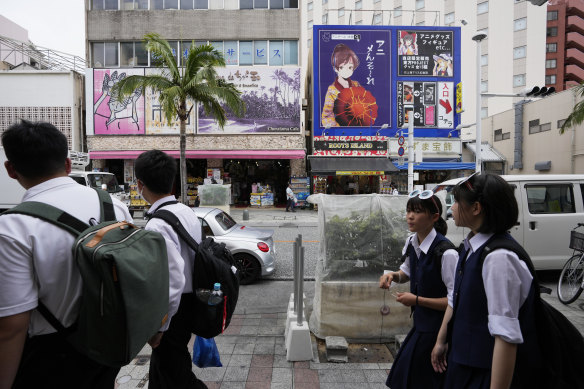Parts of Japan ‘likely to vanish’ as population shrinks
By Lisa Visentin
Tokyo: Japan’s population has plummeted for the 15th year in a row, falling by more than 861,000 people, in a relentless decline that has policymakers grasping at unprecedented measures to encourage women to have more children.
The country’s population crisis was laid bare by fresh data showing that 2023 marked the biggest single-year decline as the number of Japanese nationals hit 121.6 million people - a decrease of 861,237 people, or 0.7 per cent, from a year before, according to the Japan’s Internal Affairs Ministry.

Japan’s population has declined for the 15th year in a row, as fewer women decided to have children.Credit: AP Photo/Hiro Komae
The decline, shown in the data released last week, was not offset by an 11 per cent increase in foreign residents, which peaked at 3.3 million in 2023, also marking a record since the ministry began collecting data on this demographic factor in 2013.
Japan’s shrinking population is being driven by a stubbornly low birth rate - a challenge that many advanced economies are grappling with - and one frequently attributed to changing attitudes among women toward economic independence, the rising cost of living, and limited child support measures that see women forced to choose between having careers or a family.
However, the issue is so acute in Japan that a group of population experts called the Population Strategy Council, warned in a report in April that 744 of Japan’s 1729 municipalities were “likely to vanish” by 2050 due to population shrinkage.
Prime Minister Fumio Kishida declared last year that Japan was on the brink of social dysfunction due to the population decline, saying the few years until the 2030s represented the country’s “last chance” to reverse the trend before it would become “difficult to maintain our social security system and our local communities”.
In June, the Japanese parliament passed a law to expand monthly child allowances and parental leave, as part of what the Kishida government has called “measures of unprecedented levels” to tackle the declining birth rate.
The government earmarked 5.3 trillion yen ($34 billion) as part of the 2024 budget to fund incentives for young couples to have more children, such as increasing subsidies for childcare and education, and is expected to spend 3.6 trillion yen ($23 billion) annually over the next three years.
But experts say the measures are largely meant for married couples who plan to have or who already have children, and don’t address the growing number of young people reluctant to get married.
Japan’s population is projected to fall by about 30 per cent, to 87 million by 2070, when four out of every 10 people will be 65 or older.
Dr Yasuo Takao, a political scientist at Curtin University, has argued that Japan’s conservative lawmakers were clinging to traditional family structures when increasing numbers of younger Japanese women and men were indicating they did not want to get married.
“The way forward is to move beyond the traditional ‘standard family’ structure and ensure that individuals who want children — whether they are single or in common-law marriages — can raise them without financial or emotional insecurity,” Takao wrote in the East Asia Forum publication this month.
Renowned Japanese women’s equality advocate Dr Meguro Yoriko has claimed “the persistence of patriarchal attitudes among the men who run our corporations is the biggest reason for the continued decline in the birthrate”, and has called for measures to address gender pay gaps.
“The number of births will continue to drop as long as society insists that they take place within the traditional institution of marriage,” she argued in an analysis last year.
With AP